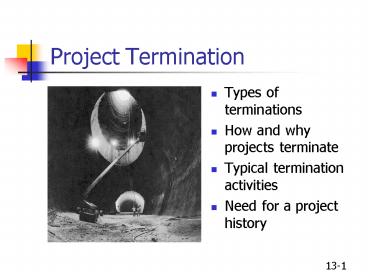Project Termination - PowerPoint PPT Presentation
1 / 16
Title:
Project Termination
Description:
Residual attitudes toward the project (client, senior ... Finding 'homes' for the team. Who will 'close the doors?' 2. Operations/Logistics/Manufacturing ... – PowerPoint PPT presentation
Number of Views:1170
Avg rating:4.0/5.0
Title: Project Termination
1
Project Termination
- Types of terminations
- How and why projects terminate
- Typical termination activities
- Need for a project history
2
All Things Come to an End . . .
- Termination rarely has much impact on technical
success or failure . . . - But a huge impact on other areas
- Residual attitudes toward the project (client,
senior management, and project team) - Success of subsequent projects
- So it makes sense to plan and execute termination
with care
3
When Do Projects Terminate?
- Upon successful completion, or . . .
- When the organization is no longer willing to
invest the time and cost required to complete the
project, given its current status and expected
outcome.
4
Most Common Reasons Projects Terminate
- 1. Low probability of technical/commercial
success - 2. Low profitability/ROI/market potential
- 3. Damaging cost growth
- 4. Change in competitive factors/market needs
- 5. Unresolvable technical problems
- 6. Higher priority of competing projects
- 7. Schedule delays
- Source Dean, 1968
5
Decision Structure for a Termination Decision,
Figure 13-1
6
Four Varieties of Project Termination
- 1. Termination by extinction
- Project has successfully completed, or it has
failed - Natural passing, or termination by murder
- Either way, project substance ceases, but much
work needs to be done - Administrative
- Organizational
7
Four Varieties of Termination (contd)
- 2. Termination by addition
- The project becomes a formal part of the parent
organization - People, material, facilities transition
- The example of Nucor
- 3. Termination by integration
- Project assets are distributed to and absorbed by
the parent
8
Four Varieties of Termination (contd)
- 4. Termination by starvation
- Withdrawal of life support
- Can save face, avoid embarrassment, evade
admission of defeat
9
Typical Termination Activities
- In general, there are seven categories of
termination tasks. Examples of activities - 1. Personnel
- Dealing with trauma of termination
- Finding homes for the team
- Who will close the doors?
- 2. Operations/Logistics/Manufacturing
- Rethinking systems
- Provisions for training, maintenance, spares
10
Termination Activities (contd)
- 3. Accounting and Finance
- Accounts closed and audited
- Resources transferred
- 4. Engineering
- Drawings complete/on file
- Change procedures clarified
11
Termination Activities (contd)
- 5. Information Systems
- Configuration and documentation in place
- Systems integrated
- 6. Marketing
- Sales and promotion efforts in line
- 7. Administrative
- All organizations aware of change
12
A Design for Project Termination, Figure 13-2
13
Project History
- One of the major aims of termination is
development and transmittal of lessons learned
to future projects - One way to do that is through a project history
14
Contents of a Project History
- 1. Project Performance
- What was achieved successes, challenges,
failures - 2. Administrative Performance
- Reports, meetings, project review procedures HR,
financial processes - 3. Organization Structure
- How structure evolved, how it aided/impeded
progress
15
Contents of a Project History (contd)
- 4. Project and Administrative Teams
- Performance of the project team, recommendations
- 5. Project Management Techniques
- Planning, budgeting, scheduling, risk management,
etc. what worked, what didnt
16
Challenges to Meaningful Project Histories
- Since the project history has so much potential
benefit, why is it often done poorly, or not at
all? - Possible reasons
- No one sees it as their job
- PM has many other priorities, especially as
project winds down - Long duration projects mean many PMs, voluminous
record, little corporate memory - PMs may be more attuned to looking forward than
looking back































